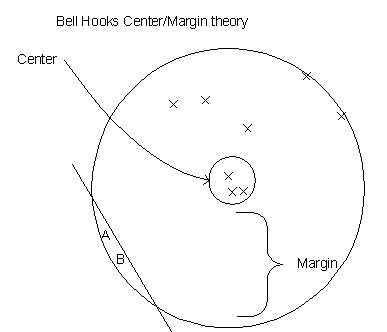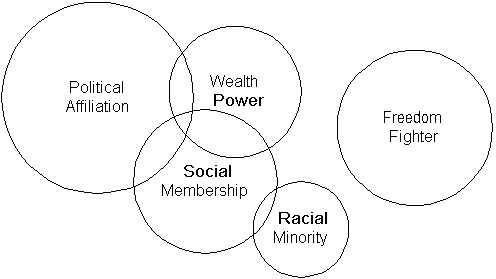For any defined group, especially one with any power, influence, or control, there is a center and a margin, where the center has more power, influence or control than the margin.

Theory: People on the margin can only move so close to the center.
- In order for a group to exist, it must have members.
- For all members, a relationship exists between group purpose and the needs of individual members.
- It is the very act exclusion that defines the center
- If the margin/fringe get too close, the center will sanction them out and retake that power (A & B above).
- Many times, being in the center is an unearned privilege.
That privilege can’t be given away or change, and might not even be deserved.
(e.g.: birth into a social caste, race, or gender) - “Awareness” is not the same thing as “shame or guilt” over membership in the center.
The latter is self defeating; the former is required to be an effective change agent. - Most often, those in the center are oblivious to the power and rank that the
center provides.
(cf.: Sitting in the Fire) - It is the responsibility of the center to move OUT.
This is true even though common talk/desire is that the margin make greater efforts to move in.- At what point does accommodating individual needs cost the group its goal?
Should the needs of the few trump the needs/rights of the many? - At what point does ignoring the individual’s needs cost the group its goal?
Should the ‘norms’ be so inflexible as to actually violate larger principles?
- At what point does accommodating individual needs cost the group its goal?
When in the center, move to the margin and partner.
There are multiple, overlapping circles, and we occupy a unique place in each of them.
Having an ability to move within any or all circles is having a sense of “agency.”

Pick any power structure and ask:
- Where am I located?
- Who occupies the center?
- How can I move within this structure?
- Who can assist me in moving?
- What level of risk to I take to move within power structures, and why?
Although rank and power are dynamic (changing in response to circumstances), there are structures/institutions to keep the fundamentals of the power structures in place.
The way to move towards the center is to use those with influence in the community to get at the center.
There are two types of capitol – agency capitol and bridging capitol.
Agency capitol: friendships/associations, membership in sub-groups, etc.
Bridging capitol: an ability to make connections with those in the center
There are different weights in being on different margins.
“I don’t like something” vs. something that makes me ill, threatens my life, or ability to put food on the table.
For any movement from the margin to the center, it is important to understand the power of emotional and perceptual biases. For example, a person who is in a room with an open door that they genuinely believe to be locked is just as caged as one who is behind a door that is really locked. Conversely, a dog on a 20′ chain that never ventures more than 15 feet from the tether perceives complete freedom, even within the confines of the leash.
